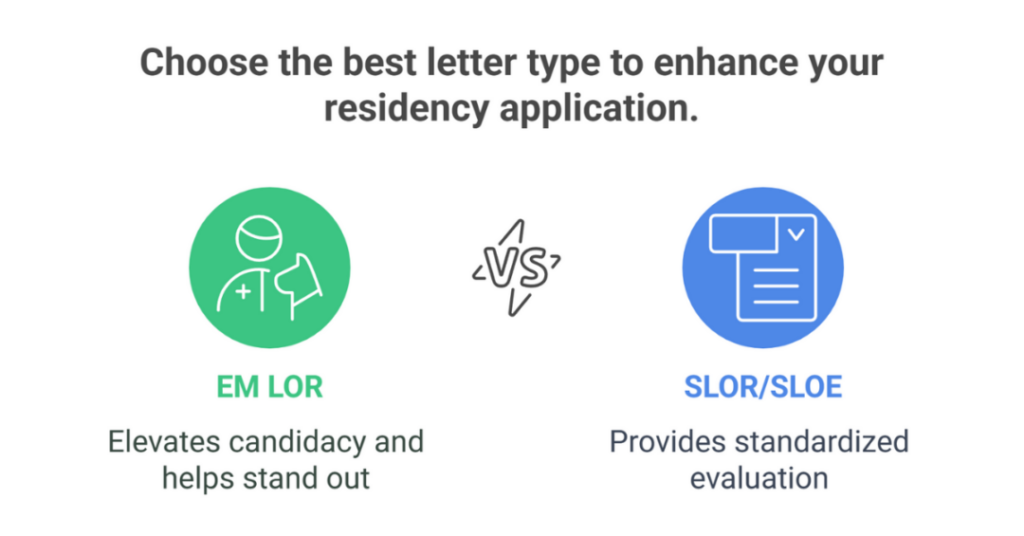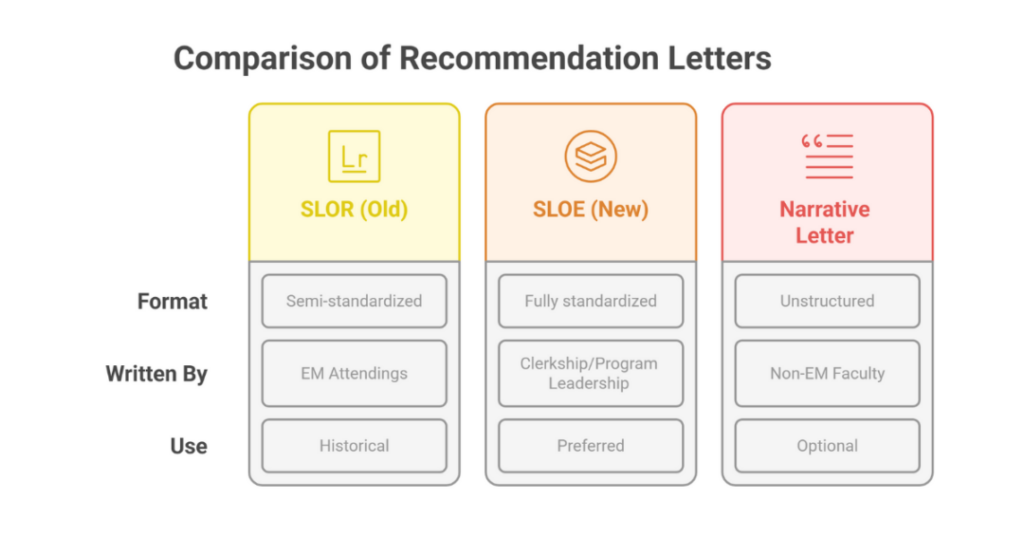14 July 2025
5 minutes read
How to Write the Best Emergency Medicine Letter of Recommendation (EM Residency and SLOR for Indian Students)?

Key Takeaways
- Emergency medicine letter of recommendation plays a crucial role in evaluating clinical skills, professionalism, and specialty fit for EM residency applicants.
- Emergency medicine letter of recommendation should follow the SLOE format to ensure credibility, consistency, and fair comparison among EM applicants.
- Emergency medicine letter of recommendation must be submitted on time through ERAS, preferably by EM faculty or a clerkship director after an EM rotation.
The process of pursuing emergency medicine residency programs in the US can be like finding your way through a labyrinth, particularly for Indian medical graduates.
But there is one document that can strongly come into play—your letter of recommendation. A clear, concise EM LOR, SLOR or SLOE can make your candidacy stand out and distinguish you from other highly qualified applicants.
What is an Emergency Medicine Letter of Recommendation?
Did you know that emergency medicine is the only specialty that widely uses a standardized format for letters of recommendation? It’s called the SLOE—Standardized Letter of Evaluation.

An emergency medicine letter of recommendation is a document written by EM staff or attendings to assess an applicant’s performance during a clinical rotation. It’s used by EM residency program directors to evaluate:
- Medical knowledge and clinical acumen demonstrated during the EM clerkship
- Professionalism and interactions with patients, attendings, and peers
- Procedural skills observed during the emergency medicine elective
- Global assessment of the applicant’s fit for the specialty
- Comparative evaluation against other residency applicants
These letters help program directors and the task force understand how well you performed during a rotation and where you stand among your peers applying to emergency medicine.
How to Write the Best EM Letter of Recommendation for Indian Students?
Fun fact: The SLOE format was created by the Council of Emergency Medicine Residency Directors to standardize evaluations and reduce inter-rater variability.
A great emergency medicine letter of recommendation needs precision, personalization, and absolute credibility. Here’s what makes it really stand out:
- Specific examples of the applicant’s composite clinical performance and initiative
- Objective assessment with minimal grade inflation and bias
- Contextual clarity on the relationship between the letter writer and the applicant
- Test scores including IELTS, TOEFL, GRE, GMAT, SAT and ACT, and relevant documents like statement of purpose, personal statement and resume.
Key Aspects to Include in the EM LOR:
| Element | Description |
|---|---|
| Letter Writer | Should be EM staff or clerkship director from a US EM program |
| Type of Letter | SLOE (Standardized Letter of Evaluation) preferred over traditional LOR |
| Evaluative Tool | Use the format available on the eSLOE website to maintain consistency |
| Comparative Ranking | Place the applicant among peers applying to emergency medicine |
| Written Comments | Provide recommendation letters with concrete observations and personal clinical experience |
This kind of detailed, honest LOR reflects the applicant’s true candidature and helps residency directors compare your performance fairly.
How to Submit Your ER Residency Application?
Here’s a fun stat: Over 90% of EM med programs prefer at least one SLOE in your application packet.
Submitting your acad application for emergency medicine residency should follow the timeline and rules of the ERAS system. Here’s what to keep in mind while making your recommendation for residency:
- Read the instructions on the ERAS and eSLOE websites carefully for the application cycle
- Get letters uploaded directly by faculty via the Letter of Recommendation Portal
- Coordinate with training program coordinators to ensure documents arrive before deadlines
What is an SLOR (Standard Letter of Recommendation) and SLOE (Standardized Letter of Evaluation)?
The SLOR, now known as the SLOE, was designed to bring uniformity to LORs. Fun fact: It was introduced in 1995 and revamped into the current SLOE format by the Council of Emergency Medicine Residency Directors (CORD).

Here’s how they differ:
- SLOR/SLOE: A structured, specialty-specific format with global assessments
- Narrative Letters: Used by non-EM faculty and often lack comparative data
- Group vs. Individual: Group SLOEs are created by a panel of EM staff, while individual SLOEs come from a single letter writer
SLOR vs. SLOE: Key Differences:
| Type | Format | Written By | Used For |
| SLOR (Old Format) | Semi-standardized | EM Attendings | Historical, less preferred now |
| SLOE (New Format) | Fully standardized | Clerkship and program leadership | Most preferred for EM residency programs |
| Narrative Letter | Unstructured | Non-EM Faculty | Optional, only if no EM faculty letters |
Using a standardized letter of recommendation increases inter-rater reliability and helps reduce grade inflation.
Sample LOR for EM
Here’s a surprising stat: EM is one of the few specialties where group SLOEs carry more weight than individual ones. Program directors want to know how you perform relative to peers.
Below is a sample emergency medicine letter of recommendation written by a faculty member for an Indian medical student applying to US EM residencies.
To Whom It May Concern,
It is my sincere pleasure to highly recommend Mr. Arjun Nair for a spot in your emergency medicine residency program. I supervised Arjun for his 4-week EM clerkship at Southside University Hospital, where I am the Clerkship Director.
Arjun routinely exhibited clinical proficiency, intellectual interest, and team-based professionalism. He was seen approaching every patient with a clear plan, an efficient take on history, and impeccable procedural technique.
He rapidly acquired the confidence of attendings and nurses as well. He performed consistently within the top 10% of the medical students rotating in our department this year.
Of particular note, Arjun offered to stay late to handle evening hours high-acuity trauma cases and was the first to react in several rapid response situations. How well he maintained his composure in stressful situations and prioritized accordingly was simply impressive.
Considering his clinical insight, commitment to emergency medicine, and professionalism, I highly recommend Arjun Nair to your program with no reservation. He is one of the most promising EM applicants I have encountered.
Sincerely,
Dr. Melissa Clarke
Clerkship Director, Dept. of Emergency Medicine
Southside University Hospital
Conclusion
A strong emergency medicine letter of recommendation can significantly influence your candidacy. Whether it’s a traditional LOR, SLOE, or group letter, its quality and structure really matter.
Please ensure that your EM faculty is aware of your strengths, adheres to the standardized letter of evaluation format, and submits your documents promptly.
It’s your story—make it count with Ambitio, your trusted abroad study partner.
FAQs
What is an emergency medicine letter of recommendation?
An emergency medicine letter of recommendation is a formal evaluation written by EM faculty or attendings assessing a student’s performance during their EM rotation.
Who should write an emergency medicine letter of recommendation?
An emergency medicine letter of recommendation should be authored by a faculty member, clerkship director, or attending affiliated with an accredited EM residency program.
How many emergency medicine letter of recommendation documents are required?
Most EM programs require at least two emergency medicine letter of recommendation submissions, with at least one being a SLOE from an accredited EM department.
Can non-EM faculty write an emergency medicine letter of recommendation?
While non-EM faculty can write an emergency medicine letter of recommendation, program directors strongly prefer SLOEs written by emergency medicine faculty members.
When should a student request an emergency medicine letter of recommendation?
It’s best to request an emergency medicine letter of recommendation immediately after completing your EM clerkship to ensure accuracy and timely submission.
How does a SLOE differ from a traditional emergency medicine letter of recommendation?
A SLOE is a standardized emergency medicine letter of recommendation that offers comparative rankings, unlike traditional narrative LORs which lack uniform assessment metrics.
Where should an emergency medicine letter of recommendation be submitted?
Each emergency medicine letter of recommendation must be uploaded to the ERAS Letter of Recommendation Portal directly by the letter writer before the application deadline.

You can study at top universities worldwide!
Get expert tips and tricks to get into top universities with a free expert session.
Book Your Free 30-Minute Session Now! Book a call now




























